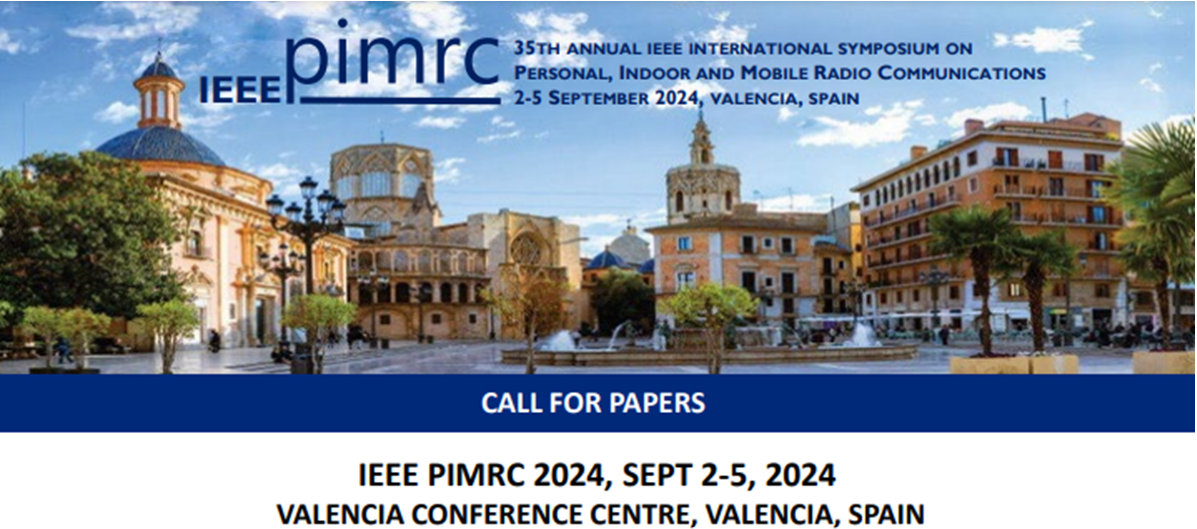
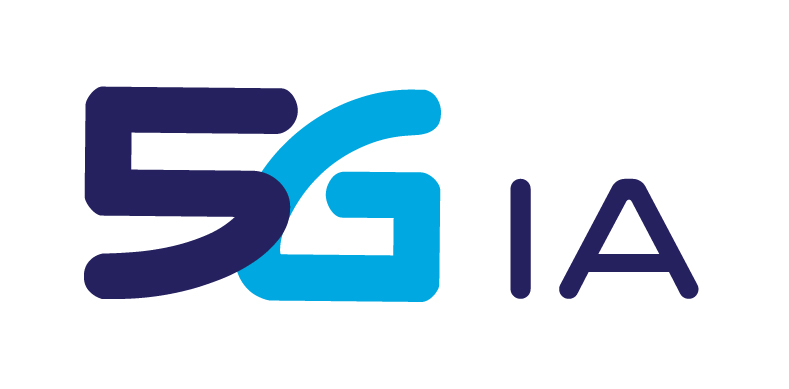
- About us
- Getting Involved
- Plans & Papers
- Events
- European 5G Activities
- Media & News
- Contact
Newsletter 34 – July August 2024
The 5G PPP initiative comes to an end with major outputs.
Key numbers |
||
| At this point in time, it is worth looking back at the 5G PPP Programme and its achievements as the final projects will be winding up before year-end 2024.The formation of the 5G PPP in 2014, as part of the European Commission’s Horizon 2020 Framework Programme, set in motion what will be ten years of research into 5G Mobile Telecoms. The work of the projects, working groups and governance structure of 5G PPP has driven forward the European contribution to the development, standardisation and commercial launch of 5G technology.
The 5G PPP (Public-Private Partnership) was indeed a European initiative launched in 2013 aimed at enhancing the competitiveness of Europe’s telecommunications sector by advancing 5G technology. This program united industry leaders, research institutions, and public bodies to foster innovation and the deployment of next-generation communication networks. The primary goals of the 5G PPP included accelerating technological development to ensure ultra-fast, reliable, and ubiquitous connectivity, and strengthening Europe’s industrial position in the global ICT landscape. The initiative supported 93 projects focusing on diverse aspects of 5G, from radio access technologies and network management to security and spectrum efficiency. By driving collaboration between public and private sectors, the 5G PPP sought to ensure that Europe remains at the forefront of 5G innovation, paving the way for future technological advancements and maintaining its leadership in global digital infrastructure. In total, 93 5G PPP projects were funded, with 783 separate organisations involved, 1,845 participants involving nearly 85,000 persons/month. A total of EUR 712.5 million was granted, of which 21.95% was allocated to SMEs, which fulfilled the KPI of at least 20%. The projects have fostered over 1200 standards contributions, more than 2,500 publications and more than 50 white papers, represent a collaborative contribution from across academia, equipment vendors, network operators, SME’s and most significantly, unprecedented engagement from other industries. This has enabled 5G PPP to develop new, innovative use cases that exploit the unique performance characteristics that characterise 5G as a new Generation, distinct from its predecessors. The programme consisted of three phases. Phase 3 was further divided into six parts. Phase 1 projects addressed 5G Concepts, Phase 2 focused on System Development, and Phase 3 was used to validate the work of the first two phases, and to demonstrate the KPIs underpinning 5G, through the building of test platforms, and the implementation of use cases derived from other industries. Phase 3 also allowed the initial groundwork on technologies ‘Beyond 5G’. As of July 2024, nearly all PPP projects have concluded their activities with only 6 Phase 3 ongoing projects. The 5G PPP projects generated outstanding results and achieved a large impact, as it has been regularly highlighted in the various documents elaborated by the 5G PPP and the 5G-IA (e.g., whitepapers, reports, brochures, roadmaps), as well as in the corresponding project websites. Collectively, 5G Infrastructure PPP projects created a portfolio of advanced European telecommunication solutions.
A full view of the progress made can be gathered by reading documents produced during the programme, including the six annual Progress Monitoring Reports (PMRs), the regularly published ‘Golden Nuggets’, the five ‘Trials & Pilots’ brochures, the seven European 5G Annual Journals, and the many working group white papers. Individual projects’ have also recorded many of their major advancements under the five ‘Key Achievements’ papers documented on the 5G PPP web site. Read more in the SB TB Review of the 5G PPP here. |
||
Reference Figures |
||
| To ensure that Europe targets technological sovereignty in all key technical areas and in order to boost and promote cross-project collaborations on commonly addressed topics, the 5G PPP TB periodically generated a Reference Figure which listed the technological areas that each of the running projects were impacting. The latest Reference Figure reflecting the active projects of 2023. The Reference Figure depicted the mapping of the Projects, in terms of their Primary and Secondary Research and Impact areas, to the targeted technological areas of the respective call.Within each call (ICT 41, ICT 42, ICT 52 & ICT 53) the Primary impact area for each project was reflected by the numbering and colouring* of the project’s main box, while the Secondary impact areas of each project were reflected by the numbering and colouring* of the annexed tabs at the top/side of each box. * It has to be noted that the impact areas of the different calls are entirely independent, and do not relate with each other, even if similar colouring has been used across the different calls.Read more here. |
||
5G PPP Trials and Pilots Brochures |
||
|
The 93 PPP projects achieved outstanding results and impact, as it has been regularly highlighted in the PPP Programme and the corresponding project websites. The PPP projects have created a plethora of advanced European telecommunication solutions. They also ensured an extremely high momentum and dynamism for the actual trials of these solutions as well as the further development of 5G systems on the road towards 6G networks, including 6G Smart Networks and Services (SNS) Joint Undertaking (JU).
The Phase 2 and Phase 3 projects have validated, trialed, and piloted the 5G technology in many vertical sectors (e.g., Automotive, Industry, Media & Entertainment, Public Safety, Health, Energy, Smart Cities, Transport & Logistics, etc.). The four “5G PPP – Trials & Pilots Brochures” released in September 2019, December 2020, August 2021 and November 2023 highlighted 40 of the most impactful Phase 2 and Phase 3 Trials & Pilots. Find the Trials and Pilots Nr. 1, the Trials and Pilots Brochure Nr. 2, the Trials and Pilots Brochure Nr. 3, and the Trials and Pilots Brochure Nr.4. and read the Summary Brochure. |
||
European 5G Annual Journals |
||
|
They documented the outcomes of various 5G PPP projects, showcasing innovative solutions, technical breakthroughs, and the impacts of 5G on different sectors such as healthcare, transportation, and manufacturing. Furthermore, the journals discussed the challenges faced, lessons learned, and future directions for 5G development, reinforcing Europe’s commitment to maintaining its leadership in the global telecommunications landscape. Through these annual publications, the 5G PPP aimed to foster knowledge sharing, collaboration, and informed decision-making, ultimately supporting the vision of a digitally connected and competitive Europe. The collection of 5G PPP European 5G Annual Journals comprised seven volumes which were published in 2016, 2017, 2018, 2019, 2020, 2021, and 2023 and distributed first at the EuCNCs. Read them here. |
||
Verticals Cartographies and Standards Tracker tools |
||
|
Vertical Cartographies The Verticals Cartographies have tracked the progress of Europe’s 5G Public Private Partnership (5G PPP) in developing 5G technology enablers and applications across diverse market segments through a large set of use cases, spanning proofs of concept, prototypes, demonstrations, trials and pilots to give consumers and vertical end-users tangible examples of 5G usage. Launched in September 2018, the Cartography was designed as a sustainable resource across Europe and globally, with regular reports on updates and impacts of 5G use cases within the 5G PPP. These are available for June 2019, March 2020 and September 2020. The replicability catalogue, which is a digital collection of 63 replicable use cases from 15 5G PPP projects was also produced: the large number of use cases covering most of the verticals was a very useful catalogue of solutions that was used by Digital Innovation Hubs (DIHs) and contributed to the acceleration of the transfer to the market. New versions are promoted within the Vertical Engagement Tracker, which is sponsored by the Smart Networks and Services Joint Undertaking (SNS JU) initiative. Annual showcase brochures of successful mature use cases stem from the competitions coordinated within the 5G-IA Trials Working Group. More information is available here. Standards Tracker tools The Standards Tracker was designed to help specialists from industry verticals navigate the various and often complex processes and stages, define technical requirements and maximise impacts with their available resources. It also guides standards specialists in embracing newcomers to create a bigger, more diverse community with potentially high impacts through mutual support. Its focus was on 5G standardisation work within 3GPP as a leader in supporting vertical industries and the roles played by associations like the 5G Infrastructure Association, 5G Automotive Association, 5G Alliance for Connected Industry and Automation and Public Safety Communication Europe. A new version of the standard tracker will be released as part of the Smart Networks and Services Joint Undertaking (SNS JU), incorporating arising discussions and future roadmaps around standardisation processes linked to emerging 6G technologies. A graphical representation of the 5G PPP’s standardisation impact is available at this link. Through the 5G PPP programme (2014-2023), Europe has been at the forefront of integrating these technologies, viewing the transition as not just technological but as a broad societal transformation. In this context, significant investments have been channelled into research and innovation, standardisation, and the development of practical applications across various sectors. This has included extensive trial and pilot projects to test and refine 5G applications, contributing to the development of an online tool, the Verticals Cartography. This tool maps 5G use cases sponsored by 5G PPP and assesses readiness across different sectors, identifying gaps and trends for future development. This white paper examines the functionality and impact of the Verticals Cartography tool, detailing its role in tracking 5G advancements. It showcases key datasets on emerging trends to understand industry-specific applications, guide future policy, devise effective industry standards and summarises the final datasets of the 5G PPP Verticals Cartography. |
||
Annual Progress Monitoring Reports |
||
|
The 5G PPP Annual Monitoring Reports provided a thorough overview of the progress, performance, and impacts of the 5G PPP initiative each year. These reports offered valuable insights into the status and advancements of 5G research, innovation, and deployment across Europe. They tracked the achievements of various 5G PPP projects, highlighting key milestones, technological innovations, and the contributions to the overall 5G ecosystem. Additionally, the reports addressed challenges encountered, solutions implemented, and the outlook for 5G development. By presenting detailed analyses and metrics, these monitoring reports served as essential tools for stakeholders, including policymakers, industry leaders, and researchers, enabling them to make informed decisions and foster continued collaboration and investment in 5G technologies. |
||
5G PPP User Vertical Webinar Series |
||
|
The 5G PPP User webinar series had been driven by a subset of 3GPP Market Representation Partners (5G-IA, 5GAA, 5G-ACIA, PSCE) to ensure requirements from industry verticals feed into 5G standardisation by encouraging the community to embrace verticals, optimally capture end-user requirements and support contributions to the standardisation process. Starting in early 2019, the event series was an excellent example of how we can intensify joint efforts across the ecosystem, working towards convergence on global standardisation. The events had attracted a global audience across 50 countries, sharing multiple viewpoints from participants as part of an open, global dialogue. The 5G PPP User Webinar series are an excellent example of how the industry can intensify joint efforts across the ecosystem working towards convergence on global standardisation, which benefits everyone. Read more here. |
||

-
- IEEE PIMRC 2024 Call for Papers -Workshop Proposals’ extension, 2-5 September, 2024
- —————————————————————————————————————————————————-
Mobicom 2024: the 30th Annual International Conference on Mobile Computing and Networking - —————————————————————————————————————————————————-
- 6G Forum – The Next Leap: Will 6G Deliver?
- —————————————————————————————————————————————————-
IEEE Future Networks World Forum 2024
- —————————————————————————————————————————————————
- ETSI Software & Standards for Smart Networks & Service Conference & Hackfests
- —————————————————————————————————————————————————-
- 6GArch – 4th International Workshop on 6G Architecture – CfP
- —————————————————————————————————————————————————-
|
|
||||||||||||||||||||||||||||||||||||||
IEEE PIMRC 2024 Call for Papers – Worskhop Proposals’ extensionValencia, Spain- 2-5 September, 2024 |
||||||||||||||||||||||||||||||||||||||
|
The 35th edition of the annual IEEE International Symposium on Personal, Indoor and Mobile Radio Communications (PIMRC) will be held in Valencia, Spain from 2-5 September. The symposium has become one of the two major conferences of the IEEE Communications Society (ComSoc) in the field of wireless communications and networking. Originally founded as a workshop in London in 1989, it developed over the years to become a major international conference, attracting technical communities from all regions and continents. After two successful editions in Asia and America, the 2024 edition returns to Europe, and will be held in face-to-face format. PIMRC 2024 will assemble worldwide experts to deliver keynotes, tutorials, workshops, industry panels, and high-quality technical sessions. Prospective authors are invited to submit original technical papers, as well as proposals for panels, tutorials, and workshops, addressing a wide range of topics in wireless and mobile communications, including but not limited to: • Communication Theory• Beyond 5G Technologies• Next-Generation Wireless Systems• New spectrum bands• Software-defined and Open Interface-based Networks• Emerging Wireless Solutions and Applications• Sustainability and Environmental Impact of Networks• Artificial Intelligence & Machine Learning in Communications• Green and Energy-Efficient Networks• Integrated Sensing, Localization and Communication• Ultra/Tera Multiple-Input Multiple-Output (MIMO)• Millimeter-Wave and Terahertz Communications• Holographic and Near-field Communications• Massive Internet of Things (IoT) and Sensor Networks• Non-terrestrial Networks• Mobile Edge, Cloud, and Fog Computing• Data-driven, Large-scale, Network Modelling and Optimization• Digital Twins and Autonomous Networks• Vehicular Communications• Wireless Security and Privacy Executive and Technical Program Chairs:
You can download the CFP here, and you can also follow them on Twitter, Facebook or LinkedIn for updates. |
||||||||||||||||||||||||||||||||||||||
MobiCom 2024: the 30th Annual International Conference on Mobile Computing and NetworkingWashington DC, USA – 30 September-4 October, 2024 |
||||||||||||||||||||||||||||||||||||||
|
|
||||||||||||||||||||||||||||||||||||||
6G Forum: The Next Leap: Will 6G deliver?Online – 1 October, 2024 |
||||||||||||||||||||||||||||||||||||||
|
|
||||||||||||||||||||||||||||||||||||||
IEEE Future Networks World Forum 2024Dubaï, UAE – 15-17 October, 2024 |
||||||||||||||||||||||||||||||||||||||
|
|
||||||||||||||||||||||||||||||||||||||
ETSI Software & Standards for Smart Networks & Service Conference & HackfestsSophia Antipolis, France – 12-14 November, 2024 |
||||||||||||||||||||||||||||||||||||||
|
The ETSI “Software & Standards for Smart Networks & Service” event will take place on 12-14 November 2024 in ETSI, Sophia Antipolis, France. Participation is open to all and free of charge upon registration.
Collaborative frameworks between industry, academia, and open source communities. Join the event to navigate the interplay of software, standardization, and research, envisioning a future where collaboration across these domains paves the way for sustainable, inclusive, and interoperable communication networks and services. Should you need any further information, please contact events@etsi.org. |
||||||||||||||||||||||||||||||||||||||
6GARch – 4th International Workshop on 6G Architecture – CfPCape Town, South Africa – 8-12 December, 2024 |
||||||||||||||||||||||||||||||||||||||
|
|
||||||||||||||||||||||||||||||||||||||
| Time | Title | Notes |
| 9.00 – 9.10 | Welcome Session | Introduction by Workshop chairs |
| 9.10 – 10.00 | Keynote 1 | TBA, 35 mins + Q&A |
| 10.00 – 10.30 | Technical Session 1 | 2 Papers, 15 min each including Q&A |
| 10.30 – 11.00 | Coffee Break | |
| 11.00 – 12.30 | Technical Session 2 | 6 Papers, 15 min each including Q&A |
| 12.30 – 14.00 | Lunch Break | |
| 14.00 – 14.50 | Keynote 2 | TBA, 35 mins + Q&A |
| 14.50 – 15.30 | Panel | Sustainability in 6G Networks, an architectural view |
| 15.30 – 16.00 | Coffee Break | |
| 16.00 – 17.15 | Technical Session 3 | 6 Papers, 15 min each including Q&A |
| 17.15 – 17.30 | Concluding Remarks | Conclusions of the session by Workshop chairs |
We expect a total of around 30 submissions out of which 12-14 papers will be selected (yielding an acceptance rate of around 40%, which can be adjusted in line with the conference guidelines). With the appropriate publicity plan, discussed below, we expect to get between 40 and 60 attendees. We plan to invite two keynote presenters: one from industry and one from academia, to provide a forward looking perspective on innovation and forward looking research challenges.
Panel: This session will take the form of an interactive question-and-answer session in which invited panelists will answer questions from the chair and the audience. Panelists will be selected among the organizers and the TPC members. The topic will be “Sustainability in 6G Networks, an architectural view”, owing to the large interest that the topic has been raising during recent years.
8. Past editions
The 6GArch workshop is a continuation of the 5GArch Workshop. The list below provides details on the previous editions:
8.1 9th (3rd 6G)
- Workshop on 6G Architecture (3rd 6GARCH)
- In conjunction with IEEE WCNC, 21-24 April 2024, Dubai, U.A.E.
- https://wcnc2024.ieee-wcnc.org/workshop/ws-12-6garch-3rd-workshop-6g-architecture
- https://wcnc2024.ieee-wcnc.org/workshop/ws-12-6garch-3rd-workshop-6g-architecture/program
8.2 8th (2nd 6G)
- Workshop on Architectural Evolution Toward 6G Networks (2nd 6GARCH)
- In conjunction with IEEE Globecom, 4-8 December 2022, Rio de Janeiro, Brazil
- https://globecom2022.ieee-globecom.org/workshop/ws18-2nd-workshop-architectural-evolution-toward-6g-networks-6garch
- https://globecom2022.ieee-globecom.org/workshop/ws18-2nd-workshop-architectural-evolution-toward-6g-networks-6garch/program
8.3 7th (1st 6G)
- Architectural Evolution Toward 6G Networks: A European View
- In conjunction with IEEE 5G World Forum, 13-15 October 2021, Virtual Conference
- https://attend.ieee.org/wf-5g/architectural-evolution-toward-6g-networks-a-european-view/
8.4 6th
- International Workshop on 5G Architecture
- In conjunction with EUCNC 2019, June 18-21 2019, Valencia, Spain
- https://www.eucnc.eu/2019/www.eucnc.eu/workshops/workshop-8/index.html
8.5 5th
- International Workshop on 5G Architecture (5GArch 2018)
- In conjunction with IEEE ICC, 20-24 May 2018, Kansas City, USA
- https://icc2018.ieee-icc.org/workshop/5th-international-workshop-5g-architecture-5garch/program.html
8.6 4th
- International Workshop on 5G Architecture (5GArch 2017)
- In conjunction with IEEE ICC, 21-25 May 2017, Paris, France
- https://icc2017.ieee-icc.org/workshop/5garch-2017-4th-international-workshop-5g-architecture/program.html
8.7 3rd
- International Workshop on 5G Architecture
- In conjunction with EUCNC 2016, 27-30 June 2016, Athens, Greece
- https://www.eucnc.eu/2016/www.eucnc.eu/indexe1e4.html?q=node/110
8.8 2nd
- Workshop on 5G Architecture (5GArch 2016)
- In conjunction with IEEE ICC, 23-27 May 2016, Kuala Lumpur, Malaysia
- https://icc2016.ieee-icc.org/content/workshops.html#W01
8.9 1st workshop
- 5GPPP Architecture workshop (5GArch 2015)
- In conjunction with IEEE VTC-Spring 2015, EU FP7 METIS and iJOIN projects, 11-14 May 2015, Glasgow, U.K.
- https://www.ieeevtc.org/vtc2015spring/workshops.php#wkshp_4
- https://eit.rptu.de/fileadmin/funknavi/HTML/5G_Arch/index.html
- Programme of the main conference https://www.ieeevtc.org/vtc2015spring/final-program.pdf
The editor of the 5G PPP newsletter on behalf of the 6GStart Project is Carole Manero, IDATE, 601 rue Georges Méliès, 34000 Montpellier, France.
This document reflects only the views of its authors.




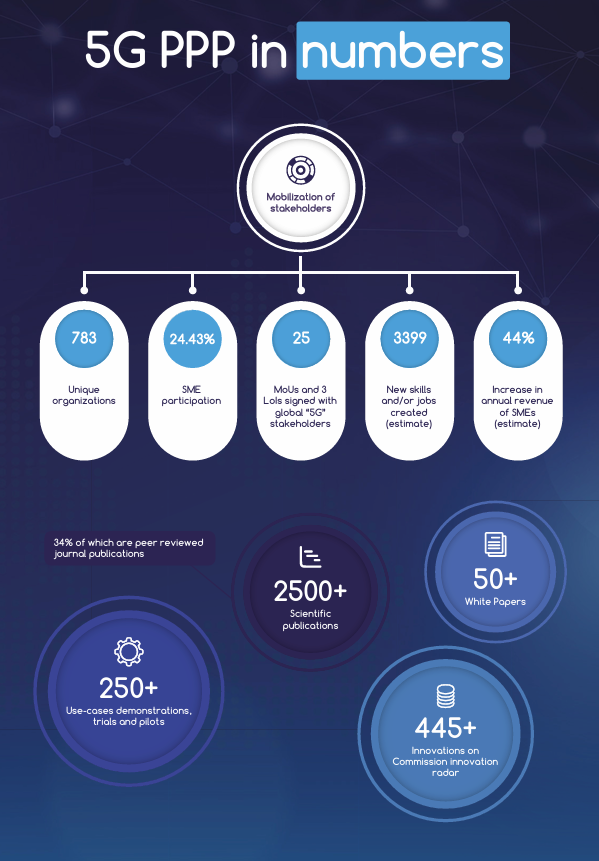
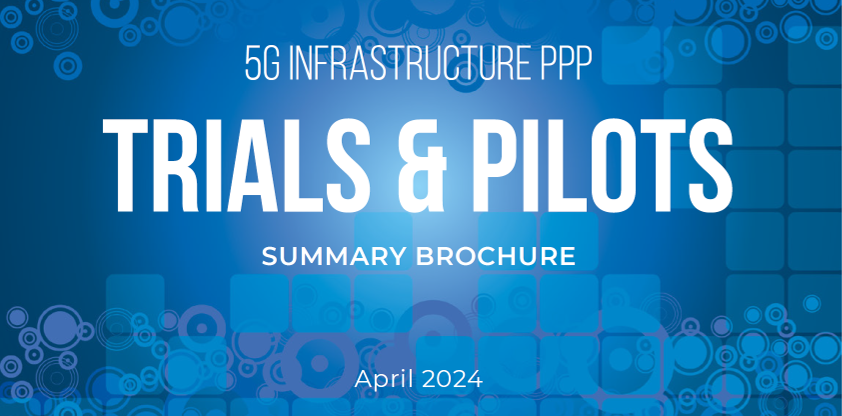 Since 2013, the 5G PPP initiative released five Trials and Pilots brochures, including the 2024 Summary Brochure. The Brochures give a synthesis of the vast of work carried out by all 5G PPP projects.
Since 2013, the 5G PPP initiative released five Trials and Pilots brochures, including the 2024 Summary Brochure. The Brochures give a synthesis of the vast of work carried out by all 5G PPP projects.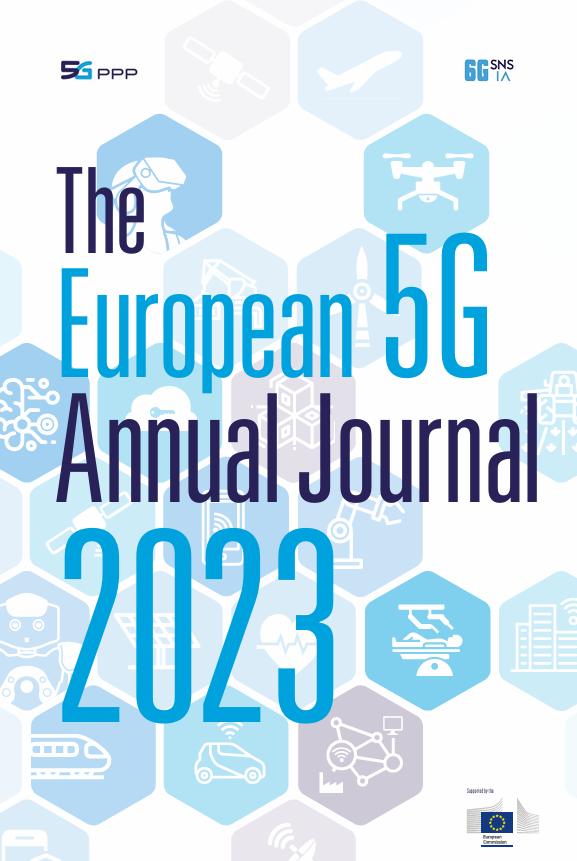 The European 5G Annual Journals were comprehensive reports published yearly, highlighting the progress and achievements of the 5G PPP initiative. These journals served as critical resources for stakeholders, policymakers, industry leaders, and researchers by providing detailed insights into the advancements in 5G technologies, applications, and deployments across Europe.
The European 5G Annual Journals were comprehensive reports published yearly, highlighting the progress and achievements of the 5G PPP initiative. These journals served as critical resources for stakeholders, policymakers, industry leaders, and researchers by providing detailed insights into the advancements in 5G technologies, applications, and deployments across Europe.